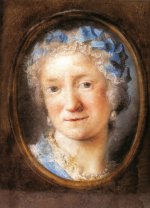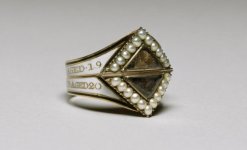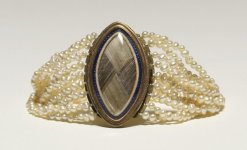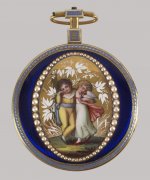Second in a series by Antique Jewelry Collector Paul Royse. See the first one here.
Antique Pearl Jewelry that YOU could own - The 1700's
By Paul Royse
The Age of Discovery, launched by Columbus discovering America, and Vasco da Gama opening the route to India, rapidly led to the development and expansion of global trade.
Pearls soon began to reach Europe in quantity from the Sea of Cort?s (off California) and the coasts around India and Ceylon (now Sri Lanka). Many of the greatest of these pearls passed to European royalty and the aristocracy.
As we saw in the introductory pictures of Elizabeth I and Feodor III, these royals acquired the most magnificent necklaces, and so many fine pearls they were able to cover their robes with them.
However amongst the aristocracy the most common displays of pearl jewelry were the wonderful pearl earrings we see in portraits of women from the 1500's to the 1700's (see Wikipedia: Females with pearl earrings in art).
Notable among these is the self-portrait of Rosalba Carriera (1675?1757), a prominent Venetian artist. Rosalba was of humble birth, however she rose to become one of the most sought-after portrait painters of Europe's rich and famous.

Rosalba's self portrait tells the viewer she now has the means to acquire a pair of earrings to rival those of the aristocrats she painted. Look closely and you'll see she is also wearing a (natural) pearl necklace which today would value in the hundreds of thousands of dollars.
Rosalba is one example of wealth spreading beyond the nobility. There were many others. In the 1700's international trade increased rapidly, and later that century the Industrial Revolution kicked off. This started a period of unprecedented growth in population and income that has continued ever since.
Items of personal jewelry were among the first things bought with new money, and the most common pieces of the time often feature seed pearls.
These include memorial (mourning) brooches and rings.

Seed pearl garnitures with a necklace, earrings and bracelets were also popular.

Seed pearls often decorated that great status symbol of the time - the pocket watch.

Collectors Tips
European and American jewelry of the 1700's (also known as the Georgian Period in the UK, and the Colonial period in the USA) was all hand made by master craftsmen and is invariably very finely made.
Unfortunately later repairs were rarely to the quality of the original, and modern day repairs can be very expensive and are often impossible. Accordingly collectors should try and find pieces in perfect condition, as bad repairs or damage render most antique pieces worth little more than scrap.
The most accessible items of the 1700's are memorial pieces. Gold rings and brooches with a woven hair insert from a dearly departed loved one are still widely available, and they're often very reasonably priced relative to their age and workmanship.
It's still possible to acquire good pieces for a few hundred dollars. Usually these will have an engraved name and dates, and thanks to on-line genealogy it's often possible to identify the person memorialized. This can add to the value immediately as pieces with provenance are especially sought after.
Pearl lovers should also remain open to the possibility of the "big score". All pearls from the 1700's were natural pearls, and large natural pearls can reach phenomenal prices.
Many of the jewels of the 1700's were lost in revolutions, wars, migrations and all sorts of turmoil since. Where are Rosabla's earrings and necklace? How many of the earrings seen in that Wikipedia article could be located today? No one knows, but some of them must be out there somewhere waiting for YOU to find them.
Anything is possible. In 2014 an eagle-eyed staff member at auction house Woolley & Wallis in Salisbury, England spotted a large pearl in a pair of earrings brought in by a member of the public. The owners had no idea of its value, or how it originally came into their family.
They were astonished to discover they had one of the largest natural pearls in the world, and were no doubt even more astonished when their pearl sold for GBP?811,000 a few months later.
Read the story here.
Photographs courtesy of Wikimedia Commons and Walters Art Museum
Part three can be seen here.
Antique Pearl Jewelry that YOU could own - The 1700's
By Paul Royse
The Age of Discovery, launched by Columbus discovering America, and Vasco da Gama opening the route to India, rapidly led to the development and expansion of global trade.
Pearls soon began to reach Europe in quantity from the Sea of Cort?s (off California) and the coasts around India and Ceylon (now Sri Lanka). Many of the greatest of these pearls passed to European royalty and the aristocracy.
As we saw in the introductory pictures of Elizabeth I and Feodor III, these royals acquired the most magnificent necklaces, and so many fine pearls they were able to cover their robes with them.
However amongst the aristocracy the most common displays of pearl jewelry were the wonderful pearl earrings we see in portraits of women from the 1500's to the 1700's (see Wikipedia: Females with pearl earrings in art).
Notable among these is the self-portrait of Rosalba Carriera (1675?1757), a prominent Venetian artist. Rosalba was of humble birth, however she rose to become one of the most sought-after portrait painters of Europe's rich and famous.

Rosalba's self portrait tells the viewer she now has the means to acquire a pair of earrings to rival those of the aristocrats she painted. Look closely and you'll see she is also wearing a (natural) pearl necklace which today would value in the hundreds of thousands of dollars.
Rosalba is one example of wealth spreading beyond the nobility. There were many others. In the 1700's international trade increased rapidly, and later that century the Industrial Revolution kicked off. This started a period of unprecedented growth in population and income that has continued ever since.
Items of personal jewelry were among the first things bought with new money, and the most common pieces of the time often feature seed pearls.
These include memorial (mourning) brooches and rings.

Seed pearl garnitures with a necklace, earrings and bracelets were also popular.

Seed pearls often decorated that great status symbol of the time - the pocket watch.

Collectors Tips
European and American jewelry of the 1700's (also known as the Georgian Period in the UK, and the Colonial period in the USA) was all hand made by master craftsmen and is invariably very finely made.
Unfortunately later repairs were rarely to the quality of the original, and modern day repairs can be very expensive and are often impossible. Accordingly collectors should try and find pieces in perfect condition, as bad repairs or damage render most antique pieces worth little more than scrap.
The most accessible items of the 1700's are memorial pieces. Gold rings and brooches with a woven hair insert from a dearly departed loved one are still widely available, and they're often very reasonably priced relative to their age and workmanship.
It's still possible to acquire good pieces for a few hundred dollars. Usually these will have an engraved name and dates, and thanks to on-line genealogy it's often possible to identify the person memorialized. This can add to the value immediately as pieces with provenance are especially sought after.
Pearl lovers should also remain open to the possibility of the "big score". All pearls from the 1700's were natural pearls, and large natural pearls can reach phenomenal prices.
Many of the jewels of the 1700's were lost in revolutions, wars, migrations and all sorts of turmoil since. Where are Rosabla's earrings and necklace? How many of the earrings seen in that Wikipedia article could be located today? No one knows, but some of them must be out there somewhere waiting for YOU to find them.
Anything is possible. In 2014 an eagle-eyed staff member at auction house Woolley & Wallis in Salisbury, England spotted a large pearl in a pair of earrings brought in by a member of the public. The owners had no idea of its value, or how it originally came into their family.
They were astonished to discover they had one of the largest natural pearls in the world, and were no doubt even more astonished when their pearl sold for GBP?811,000 a few months later.
Read the story here.
Photographs courtesy of Wikimedia Commons and Walters Art Museum
Part three can be seen here.

